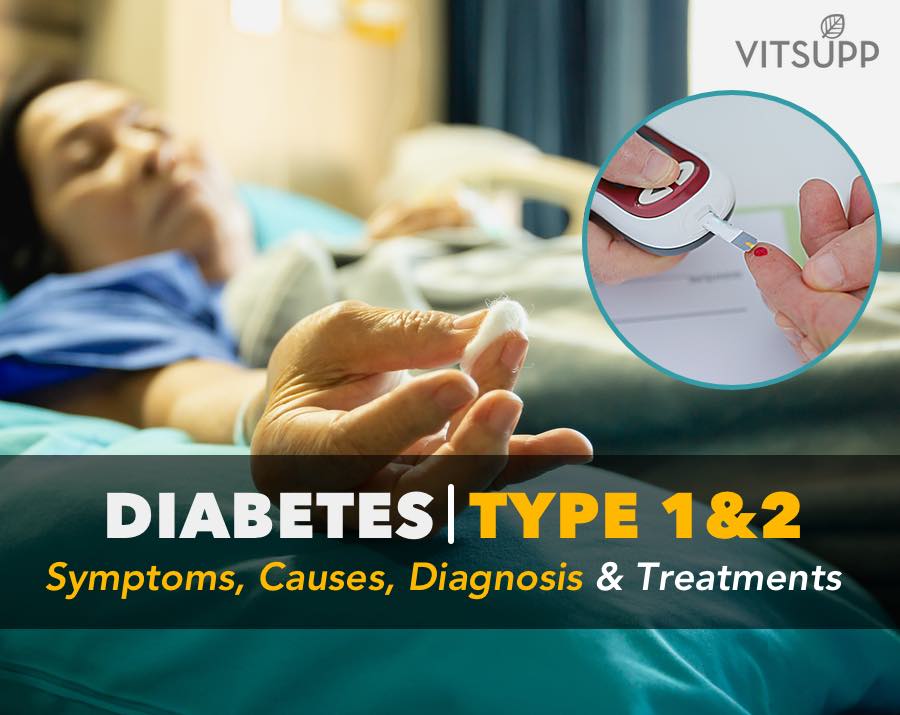Diabetes is called the “silent killer.” It is a widely prevalent condition, and its incidence is on the rise worldwide. But what is diabetes? Do you know enough about it to recognize the signs?
If you want to know more about this widely prevalent disease, you have come to the right place. Here, we talk about its signs, symptoms, and treatment. Read on.
Contents
- What is diabetes?
- What is Diabetes Mellitus?
- Types of Diabetes Mellitus
- Symptoms in Women
- Symptoms in Men
- Diagnosis and Tests
- What Causes Diabetes?
- Complications of Diabetes Mellitus
- Diabetes during Pregnancy
- Diabetes in Children
- Diabetes Prevention
- Exercise to Prevent Diabetes
- Foods to avoid
- Diabetes Medicine
- Conclusion
- FAQ
What is diabetes?
Across the world, the number of people with diabetes went up to 422 million in 2014- from 108 million in 1980. It had risen from 108 million in 1980 to 422 million in 2014. For the same period, the disease incidence for people over 18 years increased from 4.7% to 8.5%. (18)
In India, 8.7% of the total population is diabetic, according to the World Health Organization. the United States of America, 9.4% of the population has diabetes. (19)
Diabetes has also shown the maximum growth in prevalence rates among all non-communicable diseases between 1990 and 2016. (1,2)
So how can we keep this disease at bay? And how can we identify its symptoms? Let us take a thorough look at it.

Dr. Bethany Agusala is an M.D and assistant professor in the Department of Internal Medicine at UT Southwestern Medical Center and Medical Director of the William T. and Gay F. Solomon General Internal Medicine Clinic. We wanted her to explain to her what diabetes mellitus is. She said, “Diabetes is a condition where the body cannot process sugar effectively, causing various problems.
Usually, blood sugar is regulated by a hormone called insulin. Still, people with diabetes either don’t make enough, or their cells do not respond to insulin well enough to lower blood sugar levels. Chronically elevated blood sugar levels lead to other health problems such as damage to the eyes, kidneys, and nerves that could progress to blindness, kidney failure, and painful burning in the feet. It also increases the risk of heart attacks and strokes.”
What is Diabetes Mellitus?
Have you got a cut or a wound that is refusing to heal? Are you experiencing drastic weight loss without any explanation? Do you urinate frequently? These can be symptoms of high blood sugar.
Diabetes Mellitus or DM is commonly called diabetes. The term encompasses a group of metabolic disorders characterized by high blood sugar levels over an extended period. If left untreated, it can lead to many complications, including cardiovascular diseases, stroke, kidney diseases, diabetic foot ulcers, and retinal damage. (3)
According to the International Diabetes Federation, 463 million people worldwide had diabetes in 2019, with type 2 diabetes being the most prevalent form (almost 90%). Type 2 constitutes nearly 9% of the total global population, with both men and women being affected similarly. (4)
Diabetes comes in three forms- type 1 and type 2 and gestational. However, in day-to-day life, type 2 is called “diabetes.” (5)
Types of Diabetes Mellitus
There are four types of diabetes:
1. Type 1 Diabetes
It occurs when the pancreas cannot produce enough insulin, hence failing to regulate blood glucose levels. Patients with type 1 have to take insulin injections daily to stay healthy. This type of diabetes is not associated with weight gain. Earlier, it used to be called “juvenile diabetes.” (6)
Type 1 is an autoimmune disease. It means that for some reason, our immunity system attacks the cells in the pancreas, which leads to the destruction of beta cells that produce insulin. Over time, with sustained damage, the pancreas can no longer produce sufficient insulin, and hence, the patient has to depend on insulin injections. (6)
2. Type 2
It is the most common type of diabetes. a chronic condition, and people develop type 2 when their body develops insulin resistance. This means that their cells fail to respond to insulin appropriately, adversely affecting their blood sugar levels.
As the disease progresses, the body may start to produce less insulin with time. There is no cure for type 2, but you can manage it by staying healthy, monitoring the foods you eat, and exercising regularly. (7)
Earlier, it used to be called “adult-onset diabetes.” However, more children have been diagnosed with type 2 now- possibly due to the rise in childhood obesity and lack of physical activity. Though different reasons cause its onset, it is similar to type 1 as both result in high blood sugar levels and resultant complications. (8)

We asked Dr. Bethany Agusala, an M.D and assistant professor, to explain 2 types of diabetes mellitus. She said, “Type 1 diabetes is caused by an autoimmune condition where the body’s immune system incorrectly targets the pancreas’ beta cells, responsible for making insulin. As a result, they are very deficient in insulin and require multiple daily injections or an insulin pump to manage blood sugars and stay alive.
This usually occurs in children, but rarely it can present later in life. Type 2 diabetes comes from insulin resistance. Carrying excess weight, particularly around the middle, predisposes people to develop insulin resistance. The pancreas must produce more insulin to overcome the resistance and get blood sugars down. Type 2 diabetes is
3. Pre-diabetes
The name itself is self-explanatory. It is characterized by high blood sugar levels- but not as high as those observed in diabetic patients. It is also called “borderline diabetes.” Pre-diabetes increases the chances of getting heart disease, but if you lead a healthy and active lifestyle, you can stop or slow down the slide into diabetes. (19)
But where do you draw the line between pre-diabetes and diabetes proper? Check with your doctor to know. If your fasting sugar levels are within the 100-125 range, and your post-breakfast sugar levels are in the 140-199 range, you will likely have pre-diabetes. However, to make sure, the doctor can also prescribe the Hemoglobin A1C test, which checks the blood sugar levels for the last 3 months to rule out temporary irregularities. If your A1C results are in the 5.7%-6.4% range, you are pre-diabetic. (19)

4. Gestational Diabetes Mellitus
This is a condition in which a woman without diabetes shows high blood sugar levels during pregnancy. It does not have many symptoms. However, if left untreated, pregnant women can develop depression, have birth complications, and need a cesarean section while giving birth. (9)
Babies born to mothers whose gestational diabetes goes untreated can be obese and may develop type 2 diabetes. Doctors advise losing weight before pregnancy and staying active before and during pregnancy to prevent gestational diabetes. (9)
So how do you know if you have diabetes? It is always good to get checked by your doctor and check your blood sugar levels. However, you should look out for some signs- so that they do not blindside you.

Dr. Sandra El Hajj, a professor of Integrative Medicine and Public Health at Everglades University, said regarding symptoms of diabetes. “Symptoms for type-1 diabetes tend to appear suddenly and are more severe. They include excessive thirst, frequent urination, a hunger that can grow to be unreasonable, weight loss, irritability, blurred vision, and slow healing sores. Type-2 diabetes starts with pre-diabetes with symptoms that gradually begin appearing. If not addressed, they might increase in severity. The symptoms of this type of diabetes are mainly from
environmental factors and genetic predisposition.”
Diabetes Symptoms
While you have to talk to your doctor to understand what type of diabetes, you must know whether you have high blood sugar levels. The symptoms of high blood sugar are:
- Frequent urination
- Increased hunger
- Increased thirst
- Fatigue
- Blurred vision
- Unexplained weight loss
- Recurrent infections
- Wounds that refuse to heal
Symptoms in Women
1. Diabetes affects men and women equally. However, women with are likely to develop UTI or yeast infections. Due to high blood sugar levels, some women may not be able to empty their bladder- which creates a conducive environment for germs to thrive in. (20)
2. Menstrual problems are also observed in women. While it is difficult to gauge your sugar levels before and during your periods, people may experience longer or heavier periods. Also, periods often result in food cravings, which makes it difficult to control blood sugar levels. (20)
3. Diabetes may also affect your fertility and sex drive. Diabetic women have a low sex drive and may find it difficult to get pregnant. (20)
Symptoms in Men
For men, too, lack of a sexual drive is common when they have diabetes. (21)
Similarly, high blood sugar levels may lead to damage in blood vessels which are necessary to achieve or maintain an erection. While erectile dysfunction is common for many men in middle age and afterward, it is always good to talk to your doctor and see if it is a manifestation of a deeper problem or not. (21)
Diabetic men may also get urinary tract infections frequently. (21)
So if you feel that you see an incidence of one or more of these signs, visit your doctor and get checked immediately. (10)
Blood sugar can be high periodically- when under some physical or mental stress. Or after ingesting sugary foods or even as a result of some medications. However, to ensure it, you have to check your blood sugar regularly and visit a doctor who will prescribe the appropriate tests for you.
But then, what causes chronic high blood sugar levels? What are the causes of it? Let us find out.
Diagnosis and Tests
The doctor may prescribe one or more of the following tests check:
Hemoglobin A1C Test
For Type 1 and Type 2, the doctor may order a Hemoglobin A1C test. This test does not require fasting, and it identifies the blood sugar levels for three months or so. If you test for 6.5% or higher for two separate tests, you have diabetes. However, it may not be accurate if the person has any abnormalities in their hemoglobin or is pregnant. (22)
Fasting Blood Sugar Test
This blood test is done after the person has been fasting for at least 8 hours. If your blood sugar levels are below 100 mg/dL, you do not have it. Pre-diabetics clock in around 100-125 mg/DL, while diabetics show levels beyond 125mg/dL. If your values are more than 125mg/dL on two separate tests, you have diabetes. (22)
Oral Glucose Tolerance Test
This is done after the fasting test. After checking fasting sugar levels, the person will drink a sugary liquid and be tested every 2 hours. If the levels read below 140 mg/dL, it is normal. Pre-diabetics show a blood sugar level of 140-199 mg/dL, while people show more than 200 mg/dL.
Random Blood Test
Whether you ate last, a random blood test showing more than 200 mg/dL blood sugar levels usually indicates diabetes. (22)
Even if you keep track of your blood sugar levels at home with over-the-counter devices, definitely visit a doctor to know for sure whether you have diabetes or not. If you have diabetes, follow the guidance of the doctor to monitor your blood sugar levels.

Zoe Fienman is a certified diabetes educator in diabetes prevention, prediabetes, and diabetes management. She works as a lead dietitian at OnPoint Nutrition. She told us there are two types of diagnostic tests to detect diabetes in a person. “A1C measures your average blood sugar level over 2 to 3 months. An A1C below 5.7% is normal, between 5.7 and 6.4% indicates you have prediabetes, and 6.5% or higher indicates you have diabetes.
Glucose tolerance tests measure your blood sugar before and after you drink a liquid that contains a glucose solution. This test looks at the fasting BG value, 1 hour, 2 hours, and possibly 3 hours after consuming the sugar solution. A fasting blood sugar test measures your blood sugar after an overnight fast of 12 hours or more. A fasting blood sugar level of 99 mg/dL or lower is normal.”
What Causes Diabetes?
The exact causes of diabetes mellitus are not known, however, we know some probable risk factors.
Type 1 Causes
It is not known what causes type 1. As explained earlier, this happens when the pancreas cannot produce sufficient insulin. This happens when our own immunity system attacks and destroys the pancreas’ beta cells, which produce insulin. Scientists are still not clear why this happens, but they suspect several genetic and environmental factors are at play here. (11)
Type 2 Causes
Type 2 is called a “lifestyle disease,” which is usually the result of a lack of sufficient physical activity caused by a sedentary and unhealthy lifestyle.
When you develop type 2, your body is also at the risk of developing a host of other complications- especially heart diseases, high blood pressure, and diseases related to blood vessels. (11)
Type 2 begins with insulin resistance. This means that the liver, muscle, and fat cells do not respond to the insulin the body produces. As a result, your body cannot absorb blood sugar effectively.
This leads to high blood glucose levels. However, the body produces more insulin to help the organs absorb blood sugar, but over time, it falls behind the amount required, and the blood sugar levels stay high. (12)
Causes of gestational diabetes mellitus
During pregnancy, the body releases many hormones. Some hormones may lead to the buildup of blood sugar levels. Usually, the pancreas produces enough insulin to manage that, but it is the other case in many women.
When the pancreas cannot produce enough insulin to control the blood sugar buildup in a pregnant woman’s body, they develop gestational diabetes. (13)
While type 1 is autoimmune, you can keep type 2 (and to some extent, gestational diabetes) at bay if you lead an active and healthy lifestyle and follow a healthy diet. So let us take a look at ways to prevent it.
Diabetes Risk Factors
It is commonly known that in order to know if you have diabetes, you must take blood sugar tests. However, some vulnerable groups are more likely to get diabetes (22):
- People with a BMI of more than 25 exhibit other risk factors like high blood sugar levels, heart diseases, polycystic ovary syndrome, or a family history of diabetes.
- Women with gestational diabetes
- The People over 45 years of age
- Prediabetic people.
- If you belong to any of the groups mentioned above, make sure to check with your doctor about diabetes tests.
- People who have an unhealthy lifestyle- especially those who eat junk food regularly and are not physically active.
Complications of Diabetes Mellitus
As said earlier, diabetes is basically incurable. Over time, it can result in a lot of complications. Here are some long term effects of diabetes:
1. Heart disease and related complications
Heart diseases are a significant cause of death among people with diabetes because they have a higher chance of developing heart diseases. Moreover, high blood sugar levels may also damage blood vessels, which can result in further complications. People with diabetes may also suffer from strokes more often. (23)
2. Loss of feeling and effect on nerves
Diabetes can damage your nerves. If you experience numbness or tingling feeling, check with your doctor. Other symptoms include constipation or diarrhea, pain, and loss of feeling in the legs. (24)
3. Problems in feet
You must check your feet for signs of diabetic foot. Diabetes reduces blood supply to your feet (because it is the farthest from your heart), which may lead to your feet having sores, cuts, or blisters that don’t heal.
Apart from numbness, untreated sores in the feet can lead to gangrene, which has to be amputated. It is a fairly common occurrence, so make sure that you do not get cuts and infections on your feet.
Keep your feet covered, and keep them dry and clean. (24)
4. Problems in eyes
Diabetes may damage the blood vessels in your eye and lead to problems in the retina. If you have diabetes, make sure you check your eyes regularly.
People may experience sight problems, which may even lead to blindness if left untreated. If you feel like you see floating shapes or are experiencing blurred or reduced visibility and sensitivity to light, check with your doctor immediately. (24)
5. Toxic shock syndrome
Diabetes is also at increased risk of developing toxic shock syndrome (TSS).
TSS refers to a collection of syndromes that may affect multiple systems in the body. This happens when certain bacterial infections release toxins in your blood, affecting your internal organs.
This can lead to severe complications. While more common in children and the elderly, TSS is also more likely to affect people with diabetes. (25)
Diabetes during Pregnancy

Diabetic women can have a safe birth and pregnancy. However, they have to be extra careful and follow their doctor’s guidance to the T.
Since the fetus’ organs are developed in the first two months of pregnancy, high blood sugar levels in the mother may lead to complications later. (20)
If you have diabetes and are pregnant, you have a greater chance of developing toxemia or preeclampsia during the second half of your pregnancy, when the blood pressure increases and there is too much protein in your urine.
The only “cure” for toxemia is to give birth. So you must check with your doctor, follow a strict diet and activity plan, and take all the necessary medicines to make sure you and your baby stay safe and healthy. (26)
Diabetes in Children
Type 1 diabetes was earlier known as “juvenile diabetes” because it was more predominant in children. The child’s pancreas does not produce enough insulin, which results in elevated blood sugar levels. (7)
However, e are seeing more children being prediabetic or diabetic because of high blood sugar levels. This may be related to child obesity, increased intake of junk and processed food, and an overall less active lifestyle.
Girls are more prone to develop diabetes type 2, and certain demographic sections (American Indian, African-American, Asian, or Hispanic/Latino) show a propensity toward it.
If your child shows signs of insulin resistance or has a history of diabetes in your family, you should talk to your doctor to diagnose and chalking out a lifestyle plan for her. Moreover, make sure that your children stay away from sugary, junk, and processed food and get enough physical activity. (27)


Dr. Bethany Agusala is, an M.D and assistant professor in the Department of Internal Medicine at UT Southwestern Medical Center, talked about how a person can prevent diabetes. “We have good evidence that lifestyle is essential for preventing diabetes.
Eating a predominantly plant-based diet focused mainly on vegetables, fruits, whole grains such as oatmeal, brown rice, whole wheat, beans, nuts, and seeds with occasional chicken, fish, and dairy like yogurt will help keep blood sugars in a healthy range and prevent excessive weight gain. Exercise is also essential, working toward spending 30 minutes a day, 5 days a week doing moderate-intensity physical activity (moderate means that you can talk but not sing). Getting 7-9 hours of sleep helps prevent weight gain. A healthy diet, regular exercise, and sufficient rest will help weight management and avoid diabetes.”
Diabetes Prevention
If you lead a healthy lifestyle, you are less likely to develop insulin resistance and gain weight. Worldwide, doctors say that people should follow a healthy diet and stay physically active to prevent diabetes.
Here are some things to keep in mind while planning your lifestyle:
Exercise to Prevent Diabetes
This is very important. Our lifestyle has become increasingly sedentary, and most of us are either cooped up in offices or spend the whole day sitting. If you don’t get sufficient exercise, you are at risk of developing diabetes.
Exercise regularly- be it doing aerobics or resistance training or playing a sport regularly. This helps you lose weight and keep your blood sugar levels in check. (14)
Avoid Processed and Junk Food
Every person has their own nutritional needs, so it is always better to check with a doctor before making any changes to your diet. However, high blood sugar level is associated with unhealthy food, so it is best to avoid them. Avoid junk food, fast food, sugary foods like chocolates, cakes, sweet desserts, and greasy, fried foods. Try not to eat processed foods. (15)
Go for Healthy Food
Eat healthily, stay healthy. Go for fresh vegetables, whole fruits, unprocessed meats, and home-cooked meals. Unless you are allergic to gluten or certain other foods, always go for whole grains and try to substitute rice with quinoa or other healthy grains if possible. (16)
Best Foods for Diabetics
According to the Centre for Disease Control of the United States, a diabetic patient (or those who want to prevent it) should include the following in their diet. (17)
Non-starchy vegetables like beans, broccoli, cauliflower, cabbage, and carrots.
Leafy greens.
A small number of starchy foods like rice, potatoes, or pasta.
Healthy proteins like pulses and beans.
Lean meats like chicken, turkey, and fish.
Whole grains.
Foods to avoid
As the Centre for Disease Control for the United States says, you should avoid certain foods if you have diabetes. So make sure you eat sparingly:
Starchy vegetables like potatoes.
Sugary food.
Junk food.
Carbonated drinks or sweetened drinks.
Sweets, chocolates, and cakes. (17)
Remember, you should eat healthily, but make sure that you do not deprive yourself of essential nutrients. So, consult your doctor and dietitian, who will be able to help you design a food chart that is right for you.
Diabetes Medicine
In no case one should self-medicate. Talk to your doctor and stick to the prescribed medicines. Diabetes is not easy to manage, and if you do need medication or insulin injections, you must follow what your doctor prescribes.
Conclusion
We should all follow a healthy lifestyle, monitor our health care, and go for regular checkups with the doctor. This is doubly important for those who have a family history of diabetes. Living with diabetes is not easy, but if you make some simple changes to your lifestyle, you can stay fit and happy.
FAQ
Q1 what is type 1 diabetes?
Type 1 diabetes is an autoimmune disease. It means that for some reason, our immunity system attacks the cells in the pancreas, which leads to the destruction of beta cells that produce insulin. Over time, with sustained damage, the pancreas can no longer produce sufficient insulin, and hence, the patient has to depend on insulin injections. (6)
Q2 What is the difference between type 1 and type 2 diabetes?
If you or your loved one is diagnosed with this disease, you will certainly get confused with the two terms that are commonly used with diabetes. Many of our readers ask us about the difference between Type1 and type 2 diabetes
Well, as both are types of these disease there are several things that are common, but there are a lot of differences. These differences are characterized by causes, management and the type of patients who could be suffering from them.
Nevertheless, please understand that both the types are very serious and can lead to serious health complications. Therefore you need to take the right steps to manage it.
Type 1 vs Type 2 Diabetes
| Type 1 Diabetes | Type 2 Diabetes | |
| Incidenc | Approx 8% Diabetic are suffering from Type 1 Diabetes. | Approx 90% Diabetic are suffering from Type 2 Diabetes. |
| What is happening? | It is an autoimmune condition. It means that your body attacks the cells in your pancreas, therefore it cannot make any insulin. | Your body is unable to make enough insulin or the insulin you do make doesn’t work properly. |
| Diabetes Risk factors (Causes of diabetes mellitus) | Type 1 diabetes causes are not exactly known. | type 2 diabetes causes could be your family history, ethnic background, age and your weight (if you’re overweight or obese) |
| Prevention | It isn’t affected by your lifestyle or weight. What it means is that you can not change the risk of developing Type 1 disbetes by lifestyle changes. | Certain lifestyle changes can help you reduce your risk of developing Type 2 diabetes. If you eat healthy, stay active and maintain a healthy weight can help you to prevent Type 2. |
| Incidence | Primarily children and people upto the age of 40 are diagnosed with it. Though uncommon, people over 40 may be diagnosed with it. | You are likely to have Type 2 if you are over the age of 40. However, Type 2 Diabetes is becoming more common in younger people. |
| Symptoms | The symptoms for Type 1 Diabetes appear quickly and are difficult to ignore as it can leade to Diabetic ketoacidosis (DKA) – a life threatening emergency. | Type 2 diabetes symptoms appear gradually and therefore it is easy to miss the onest of this type. It is possible that one have diabetes for 10 years and they still are unaware about it. |
| Management | One can manage Type 1 diabetes by taking an adequate dosage of insulin to control ones blood sugar level. You need to test your blood glucose levels regularly and need to count carbs (carbohydrates) you eat and drink. If you count your carbs it will help you figure how much insulin you should take. | One can manage Type 2 diabetes with medication, exercise and diet. People with Type 2 Diabetes can also be prescribed insulin. You also need to manage your weight. |
| Cure and Prevention | Currently there is no cure for Type 1 but research continues. | Type 2 cannot be cured but there is evidence to say in many cases it can be prevented and put into remission. |



